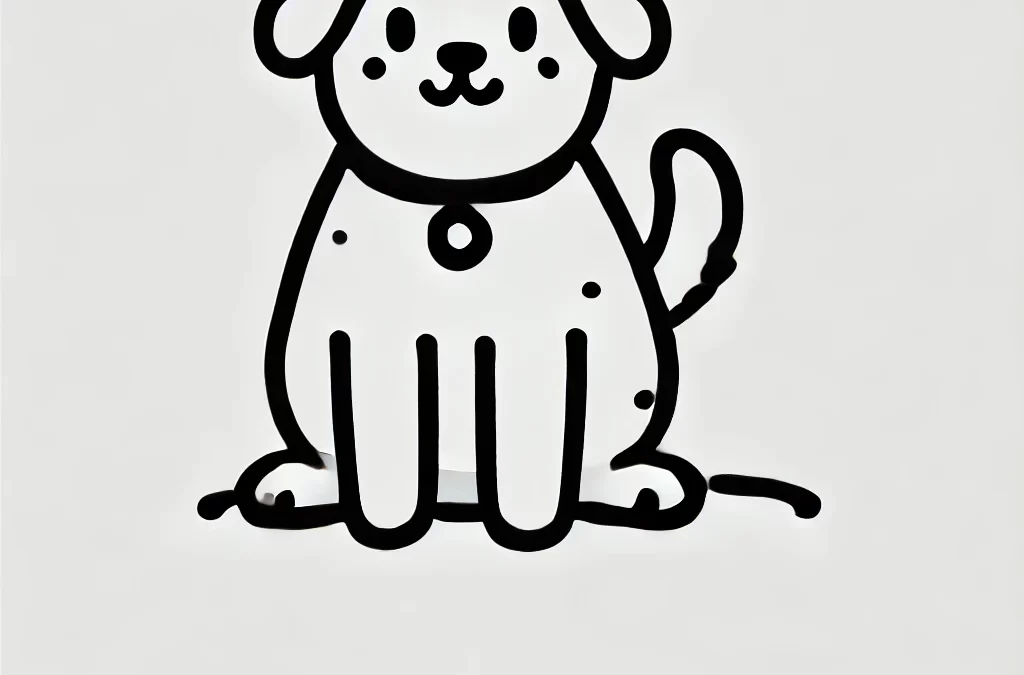
door TCMVET | 6 februari 2025 | Hondenkanker en tumoren
Milttumoren bij honden worden vaak aangeduid als “stille moordenaars” omdat ze onopgemerkt lang kunnen groeien, met minimale symptomen totdat ze een medisch noodgeval worden. Veel huisdiereigenaren realiseren zich pas dat hun hond een milttumor heeft wanneer er plotselinge inwendige bloedingen optreden. De risico's, tekenen en behandelingsopties begrijpen voor hondenmilt tumoren is cruciaal voor vroege detectie en interventie.
Wat zijn milttumoren bij honden?
De milt is een belangrijk orgaan dat helpt bij bloedfiltratie, immuunfunctie en ijzerrecycling. Tumoren in de milt kunnen goedaardig (niet-kankerachtig) of kwaadaardig (kankerachtig)De meest voorkomende soorten milttumoren bij honden zijn:
- Hemangioma – Een goedaardige tumor die bestaat uit bloedvaten.
- Hemangiosarcoom (HSA) – Een zeer agressieve vorm van kanker die ontstaat in de cellen van de bloedvaten en een groot risico loopt om zich naar andere organen te verspreiden.
- lymfoom – Een vorm van kanker die het lymfestelsel aantast en de milt kan aantasten.
- Nodulaire hyperplasie van de milt – Een goedaardige aandoening waarbij de milt abnormale knobbeltjes vormt die alsnog kunnen scheuren en bloedingen kunnen veroorzaken.
Onder deze, hemangiosarcoom is het gevaarlijkst en is verantwoordelijk voor een groot percentage van de milttumoren. Het komt vooral veel voor bij rassen zoals Golden Retrievers, Duitse Herders en Labrador Retrievers.
Symptomen van milttumoren bij honden
Vroegtijdige detectie van milttumoren is moeilijk omdat veel honden asymptomatisch blijven totdat de tumor aanzienlijk groeit of scheurt. Enkele signalen om op te letten zijn:
- Lethargie of zwakte – Uw hond lijkt misschien moe en minder actief dan normaal.
- Bleek tandvlees – Een teken van bloedarmoede, vaak als gevolg van inwendige bloedingen.
- Plotselinge ineenstorting – Dit kan gebeuren als de tumor scheurt en inwendige bloedingen veroorzaakt.
- Vergrote buik – Een opgezwollen buik kan duiden op een groeiende tumor of inwendige bloedingen.
- Verlies van eetlust en gewichtsverlies – Geleidelijke afname van eetgedrag en lichaamsgewicht.
- Snelle ademhaling of verhoogde hartslag – Een teken van een laag bloedvolume of zuurstoftekort.
Als uw hond zich laat zien een van deze symptomen, zoek dan onmiddellijk veterinaire hulp, vooral als ze in elkaar zakken of bleek tandvlees hebben.
Hoe worden milttumoren gediagnosticeerd?
Een dierenarts gebruikt doorgaans de volgende methoden om milttumoren te diagnosticeren:
- Fysiek onderzoek – Controleren op een vergrote buik of tekenen van bloedarmoede.
- Echografie – Helpt massa’s in de milt te visualiseren.
- röntgenstralen – Kan een vergrote milt of tekenen van uitzaaiingen vertonen.
- Blood Tests – Detecteert bloedarmoede, afwijkende aantallen witte bloedcellen en veranderingen in de orgaanfunctie.
- Fijne-naaldaspiratie of biopsie – Helpt bepalen of de tumor goedaardig of kwaadaardig is.
In veel gevallen, Een definitieve diagnose kan pas gesteld worden nadat de milt operatief verwijderd en onderzocht is.
Behandelingsopties voor milttumoren bij honden
1. Chirurgie (Splenectomie)
Als er een milttumor wordt ontdekt, is de meest gebruikelijke behandeling: splenectomie (chirurgische verwijdering van de milt)Honden kunnen zonder milt leven, maar als de tumor kwaadaardig is, is een operatie alleen vaak niet voldoende om de voortgang van de kanker te stoppen.
2. Chemotherapy
Voor hemangiosarcoom, chemotherapie kan worden aanbevolen na een operatie om de verspreiding van kanker te vertragen. De prognose blijft echter slecht, met een gemiddelde overlevingstijd van 3 tot 6 maanden zelfs met behandeling.
3. Natuurlijke en holistische ondersteuning
Sommige huisdiereigenaren verkennen natuurlijke therapieën om het immuunsysteem en de kwaliteit van leven van hun hond te ondersteunen. Mogelijke opties zijn:
- Medicinale paddenstoelen (zoals kalkoenstaart en reishi) – Kan helpen de immuunfunctie te ondersteunen.
- TCM (Traditionele Chinese Geneeskunde) kruiden – Sommige kruidenmengsels, zoals Baituxiao, zijn gebruikt voor de behandeling van tumoren.
- Dieetveranderingen – Een eiwitrijk, ontstekingsremmend dieet kan de algehele gezondheid ondersteunen.
Hoewel deze opties kan kanker niet genezen, ze kunnen het welzijn verbeteren en de voortgang van de ziekte vertragen.
Kunnen milttumoren voorkomen worden?
Hoewel er geen gegarandeerde manier is om milttumoren te voorkomen, kunnen huisdiereigenaren maatregelen nemen om de risico's te verkleinen:
- Regelmatige dierenartscontroles – Vroegtijdige detectie door routinematige onderzoeken en echo’s bij risicorassen.
- Vermijd blootstelling aan kankerverwekkende stoffen – Beperk de blootstelling aan pesticiden, meeroken en dierenvoer van lage kwaliteit.
- Ondersteun de gezondheid van het immuunsysteem – Een uitgebalanceerd dieet met antioxidanten kan helpen celschade te voorkomen.
Laatste gedachten
Milttumoren bij honden vormen een ernstig gezondheidsprobleem, vooral hemangiosarcoom, die vaak onopgemerkt blijft totdat het levensbedreigend wordt. Regelmatige veterinaire controles, alert zijn op subtiele symptomen en snel handelen als uw hond tekenen van stress vertoont, kunnen een cruciaal verschil maken. Als bij uw hond een milttumor is vastgesteld, bespreek dan de behandelingsopties met uw dierenarts om de beste handelwijze voor de kwaliteit van leven van uw huisdier te bepalen.
Door goed geïnformeerd en proactief te blijven, kunnen huisdiereigenaren hun hond de best mogelijke zorg en ondersteuning bieden in deze moeilijke tijd.
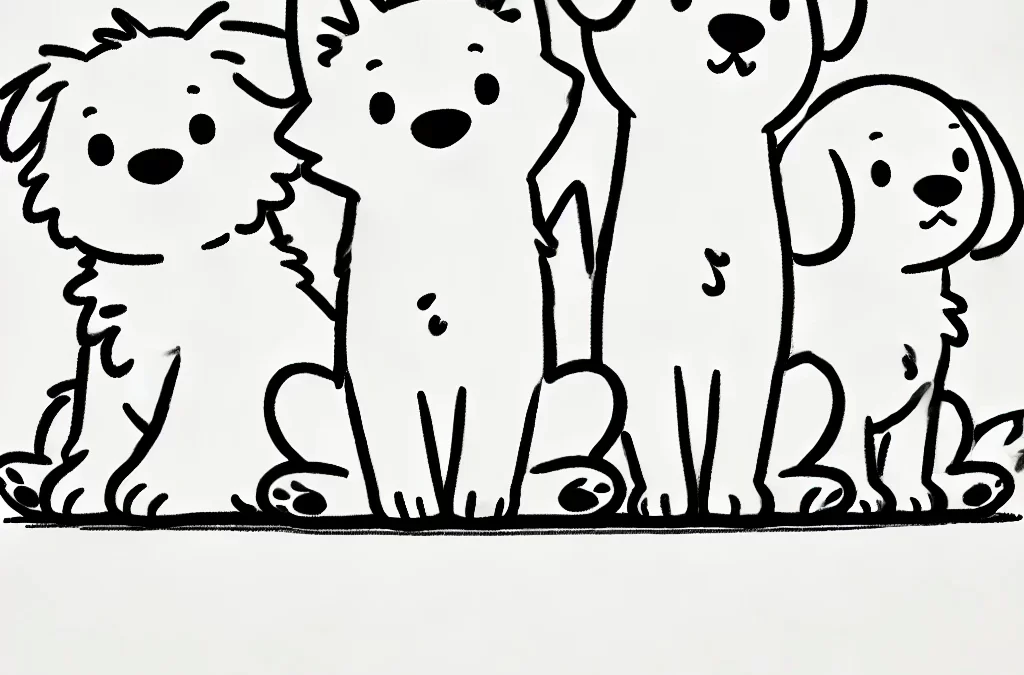
door TCMVET | 6 februari 2025 | Hondenkanker en tumoren
Kanker is een groeiende zorg voor huisdiereigenaren, vooral degenen met meerdere honden. Wanneer een hond in het huishouden de diagnose kanker krijgt, rijst een veelvoorkomende vraag: Is kanker bij honden besmettelijk? Als u de aard van kanker begrijpt en weet hoe het zich verspreidt, kunnen huisdiereigenaren de juiste voorzorgsmaatregelen nemen en hun harige metgezellen zo goed mogelijk verzorgen.
Is kanker besmettelijk bij honden?
Het simpele antwoord is Nee—de meeste vormen van kanker bij honden zijn niet besmettelijk. In tegenstelling tot infectieziekten die worden veroorzaakt door virussen of bacteriën, is kanker de ongecontroleerde groei van abnormale cellen in het lichaam van een individu. Het verspreidt zich niet van de ene hond naar de andere door direct contact, gedeelde voerbakken of nabijheid.
Er zijn echter zeldzame uitzonderingen, zoals overdraagbare geslachtsziekte tumoren (TVT), die zich kan verspreiden door direct contact, met name tijdens de paring. TVT is een van de weinige natuurlijk voorkomende overdraagbare kankers bij honden, en het treft vooral zwerfhonden of niet-gecastreerde honden. Afgezien hiervan kunnen conventionele kankers zoals lymfoom, osteosarcoom en mastceltumoren niet tussen honden worden overgedragen.
Kan kanker worden beïnvloed door omgevingsfactoren?
Hoewel kanker op zichzelf niet besmettelijk is, kunnen honden die in hetzelfde huishouden leven, veel voorkomende milieurisico's die kunnen bijdragen aan de ontwikkeling van kanker. Deze omvatten:
- Blootstelling aan meeroken – Honden in huishoudens waar wordt gerookt, lopen een groter risico op longkanker en neustumoren.
- Giftige chemicaliën – Pesticiden, herbiciden en schoonmaakmiddelen voor in huis kunnen het risico op kanker bij huisdieren vergroten.
- Dieet en obesitas – Een slecht dieet en obesitasgerelateerde ontstekingen kunnen op den duur bijdragen aan de ontwikkeling van kanker.
- Genetics – Als er in één huishouden meerdere honden van dezelfde bloedlijn of hetzelfde ras zijn, kunnen ze een genetische aanleg hebben voor bepaalde vormen van kanker.
Wat moeten eigenaren van meerdere honden doen?
Ook al is kanker niet besmettelijk, toch moeten huisdiereigenaren bepaalde voorzorgsmaatregelen nemen om de gezondheid en het welzijn van hun hond te waarborgen:
1. Zorg voor een gezonde omgeving
- Zorg dat uw huis vrij is van schadelijke stoffen, zoals sigarettenrook en agressieve chemicaliën.
- Gebruik geen pesticiden en herbiciden op plekken waar uw honden spelen.
2. Ondersteun een voedzaam dieet
- Geef alle honden een uitgebalanceerd, hoogwaardig dieet met verse, natuurlijke ingrediënten.
- Overweeg supplementen die de gezondheid van het immuunsysteem ondersteunen, zoals omega 3-vetzuren en antioxidanten.
3. Let op symptomen bij andere honden
- Controleer regelmatig op knobbeltjes, zwellingen, gewichtsverlies of gedragsveranderingen.
- Plan jaarlijkse veterinaire controles en routinematige kankeronderzoeken in, vooral bij oudere honden of rassen die gevoelig zijn voor kanker.
4. Bied emotionele steun
- Als bij één hond kanker wordt vastgesteld, kunnen andere honden in het huishouden stress of gedragsveranderingen ervaren.
- Zorg voor een vaste routine en zorg ervoor dat alle huisdieren in huis zich op hun gemak voelen.
5. Raadpleeg een dierenarts
- Als u zich zorgen maakt over het risico op kanker bij u thuis, raadpleeg dan uw dierenarts voor persoonlijk advies over preventie en vroege detectie.
Conclusie
Kanker bij honden is niet besmettelijk, maar gedeelde omgevingsfactoren en genetische aanleg kunnen het risico op kanker bij meerdere honden in een huishouden beïnvloeden. Door een gezond huis te onderhouden, de juiste voeding te bieden en waakzaam te blijven voor symptomen, kunnen huisdiereigenaren hun honden helpen langer en gezonder te leven. Als bij een van uw honden kanker wordt vastgesteld, is het bieden van liefde, troost en passende medische zorg de beste manier om ze te ondersteunen en tegelijkertijd het welzijn van uw hele roedel te waarborgen.
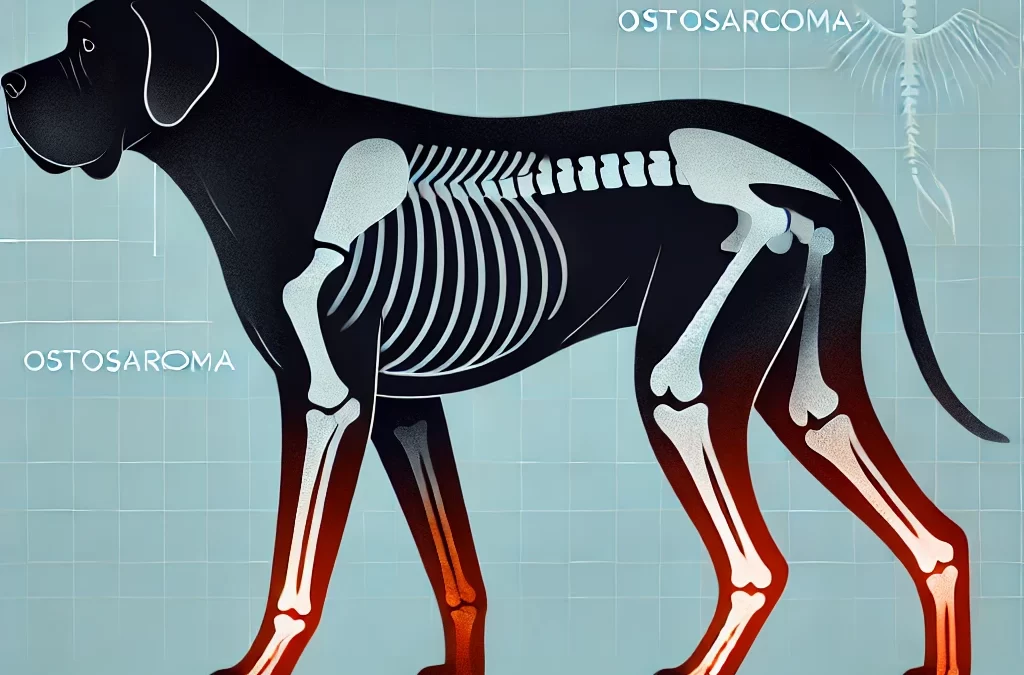
door TCMVET | 26 jan. 2025 | Hondenkanker en tumoren
Osteosarcoom (OSA) is de meest voorkomende primaire botkanker bij honden en treft onevenredig veel grote en reuzenrassen. Met zijn agressieve aard en snelle metastasering vormt deze kanker een aanzienlijke uitdaging voor huisdiereigenaren. Het begrijpen van de risicofactoren en het aannemen van preventieve strategieën kan echter een verschil maken. Dit artikel onderzoekt waarom grote honden kwetsbaarder zijn voor osteosarcoom en welke proactieve stappen eigenaren kunnen nemen om het risico te minimaliseren.
Waarom zijn grote en reuzenrassen gevoeliger voor osteosarcoom?
- Snelle groei en botontwikkeling
Grote en gigantische hondenrassen groeien snel tijdens hun eerste maanden, wat stress op hun botten legt. Deze snelle groei kan leiden tot microschade in botstructuren, wat een aanleg voor kankermutaties creëert.
- Genetische factoren
Bepaalde rassen hebben een genetische aanleg voor osteosarcoom. Veelvoorkomende getroffen rassen zijn:- Duitse Dog
- Sint Bernard
- Ierse Wolfshond
- Rottweiler
- Windhond
- Labrador retriever
- Golden retriever
- Ledemaatlengte en botspanning
Grotere honden met lange ledematen zijn gevoeliger voor botstress. Osteosarcoom komt vaak voor in gewichtdragende botten zoals de radius, ulna, humerus en femur.
- Hormonale invloed en castratie/sterilisatie
Onderzoeken suggereren dat vroegtijdige sterilisatie of castratie, met name vóór de skeletvolwassenheid, het risico op osteosarcoom kan verhogen. Er wordt aangenomen dat dit verband houdt met de verwijdering van geslachtshormonen, die een rol spelen bij de regulatie van botgroei.
- Chronische ontsteking en bottrauma
Herhaald trauma, eerdere breuken of orthopedische operaties kunnen de vatbaarheid voor kanker bij honden vergroten, vooral bij rassen die al vatbaar zijn voor osteosarcoom.
Hoe het risico op osteosarcoom bij grote honden te verminderen
- Gecontroleerde groei tijdens de puppytijd
- Vermijd calorierijke, snelgroeiende diëten die een te grote belasting vormen voor de zich ontwikkelende botten.
- Geef puppy's van grote rassen speciaal samengestelde voeding die een gestage, gecontroleerde groei bevordert.
- Evenwichtige voeding met antioxidanten
- Voeg voedingsmiddelen toe die rijk zijn aan omega-3-vetzuren, kurkuma en antioxidanten om ontstekingen en oxidatieve stress te bestrijden.
- Een dieet met gecontroleerde calcium- en fosforgehaltes ondersteunt de gezondheid van de botten, zonder dat deze te veel groeien.
- Verantwoord castreren en steriliseren
- Overweeg om sterilisatie uit te stellen totdat de hond skeletvolwassen is (meestal rond de 18-24 maanden voor grote rassen).
- Bespreek alternatieve sterilisatieopties met een dierenarts om het risico op kanker in evenwicht te brengen met de reproductieve gezondheid.
- Regelmatige lichaamsbeweging zonder overmatige belasting
- Activiteiten met een lage impact, zoals zwemmen en gecontroleerd wandelen, helpen de gezondheid van botten en gewrichten te behouden.
- Vermijd overmatig springen en herhaaldelijke activiteiten met een hoge impact, vooral bij jonge honden.
- Vroegtijdige detectie en routinecontroles
- Regelmatige veterinaire controles helpen om subtiele veranderingen in de botten vroegtijdig te ontdekken.
- Eigenaren moeten letten op signalen zoals: mank lopen, zwellingen in de ledematen, aanhoudende pijn of plotselinge bewegingsmoeilijkheden.
- Supplementen voor botsterkte
- Glucosamine en chondroïtine: Ondersteunt de integriteit van gewrichten en botten.
- Vitamine D & K2: Helpt bij de opname van calcium en de botdichtheid.
- Curcumine en medicinale paddenstoelen: Vertoont ontstekingsremmende en potentiële antikankereigenschappen.
- Vermijden van milieutoxines
- Beperk de blootstelling aan bekende kankerverwekkende stoffen, waaronder pesticiden, tabaksrook en bewerkte diervoeding met kunstmatige toevoegingen.
Laatste gedachten
Hoewel grote en reuzenrassen een hoger risico lopen op osteosarcoom, kan preventieve zorg een belangrijke rol spelen bij het verminderen van deze dreiging. Een uitgebalanceerd dieet, gecontroleerde beweging, verantwoord fokken en regelmatige gezondheidscontroles kunnen huisdiereigenaren helpen risico's effectief te beheren. Proactief zijn verbetert niet alleen de levensduur van een hond, maar verbetert ook hun algehele kwaliteit van leven. Als u tekenen van kreupelheid of zwelling opmerkt, raadpleeg dan een dierenarts, want vroege diagnose is cruciaal voor het verbeteren van de resultaten.
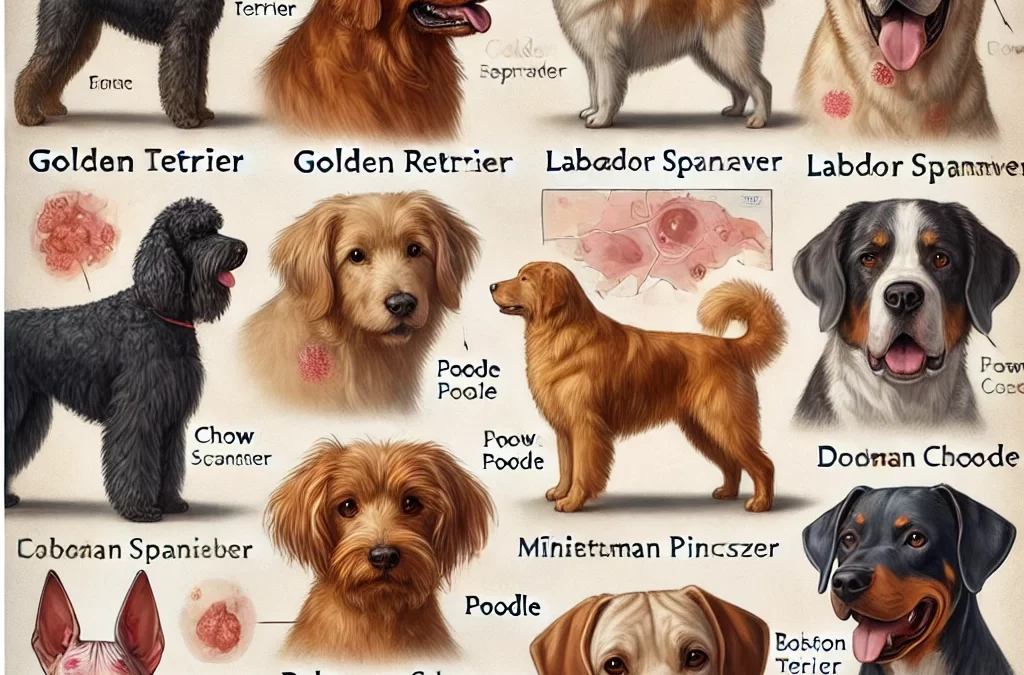
door TCMVET | 26 jan. 2025 | Hondenkanker en tumoren
Melanoom is een van de meest zorgwekkende vormen van kanker bij honden, die vaak in de mond, huid, nagelbedden en zelfs de ogen voorkomen. Hoewel alle honden melanoom kunnen ontwikkelen, zijn bepaalde rassen genetisch gepredisponeerd vanwege hun pigmentatie, huidkenmerken en andere biologische factoren. Dit artikel onderzoekt welke hondenrassen vatbaarder zijn voor melanoom, de rol van omgevingsfactoren en hoe huisdiereigenaren preventieve maatregelen kunnen nemen.
Waarom zijn sommige rassen gevoeliger voor melanoom?
Melanoom ontstaat uit melanocyten, de pigmentproducerende cellen in het lichaam van een hond. De volgende factoren dragen bij aan een verhoogd risico bij bepaalde rassen:
- Genetische aanleg – Sommige rassen erven een grotere kans op abnormale melanocytengroei.
- Pigmentatie en vachtkleur – Honden met een donkere pigmentatie, met name zwartharige rassen, zijn vaak gevoeliger voor oraal melanoom. Omgekeerd zijn licht gepigmenteerde honden gevoeliger voor huidmelanoom op plekken die aan de zon zijn blootgesteld.
- Omgevingsfactoren – Langdurige blootstelling aan de zon, de werking van het immuunsysteem en zelfs het dieet kunnen de ontwikkeling van melanoom bij honden beïnvloeden.
Rassen met een hoger risico op melanoom
Uit onderzoek en veterinaire casestudies blijkt dat de volgende rassen een hoger risico lopen op het ontwikkelen van melanoom:
- Schotse Terriër – Vaak gekoppeld aan huidmelanoom, vooral op plekken die aan de zon worden blootgesteld.
- Golden retriever – Vatbaar voor verschillende soorten kanker, waaronder melanoom, vooral in de mond.
- Labrador retriever – Er zijn meer gevallen van oraal melanoom gemeld.
- Cocker Spaniël – Hogere incidentie van melanoom, vooral in de ogen (oculair melanoom).
- Chow Chow – Hun donkere pigmentatie verhoogt de vatbaarheid voor oraal melanoom.
- Poedel – Bij miniatuur- en standaardpoedels is nagelbedmelanoom vastgesteld.
- Teckel – Grotere kans op het ontwikkelen van huidmelanoom vanwege genetische factoren.
- Dobermann Pinscher – Hogere incidentie van orale en nagelbedmelanomen.
- Miniatuur Schnauzer – Gevoelig voor zowel huid- als oraal melanoom.
- Boston Terriër – Verhoogd risico op huidmelanoom, vooral bij lichtere personen.
Omgevings- en levensstijlfactoren die het risico verhogen
Ook als een hond niet tot een risicovol ras behoort, kunnen externe factoren de ontwikkeling van melanomen beïnvloeden:
- Blootstelling aan de zon – Honden met een lichtere huid of dunne vacht lopen risico op door UV-straling veroorzaakt huidmelanoom.
- Mondhygiëne – Slechte mondverzorging kan bijdragen aan ontstekingen, waardoor het risico op orale melanomen mogelijk toeneemt.
- Leeftijd – Oudere honden zijn gevoeliger voor cellulaire mutaties die leiden tot melanoom.
- Gifstoffen en dieet – Blootstelling aan chemicaliën en een gebrek aan antioxidanten in het dieet van een hond kunnen een rol spelen bij de vatbaarheid voor kanker.
Preventieve maatregelen voor hondenbezitters
- Routinecontroles bij de dierenarts – Vroege detectie is cruciaal, vooral bij risicovolle rassen.
- Mond- en huidonderzoeken – Controleer regelmatig de binnenkant van de bek, poten en huid van uw hond op ongewone gezwellen.
- Bescherming tegen zonnebrand – Honden met een lichte huid moeten overmatige blootstelling aan de zon vermijden. Een huisdiervriendelijke zonnebrandcrème kan hierbij helpen.
- Een evenwichtig dieet – Antioxidanten en omega-3-vetzuren kunnen de immuunfunctie ondersteunen en ontstekingen verminderen.
- Zorg voor een goede mondgezondheid – Door de tanden van uw hond te poetsen en hem kauwsnacks te geven, kunt u het risico op orale melanomen verkleinen.
Laatste gedachten
Hoewel melanoom een agressieve kanker is, kan bewustzijn van rasspecifieke risico's en proactieve zorg helpen bij vroege detectie en preventie. Regelmatige controles, een gezond dieet en waakzame monitoring kunnen een groot verschil maken in de gezondheid van een hond. Als u ongebruikelijke bulten opmerkt, vooral in de bek van uw hond, raadpleeg dan zo snel mogelijk een dierenarts.
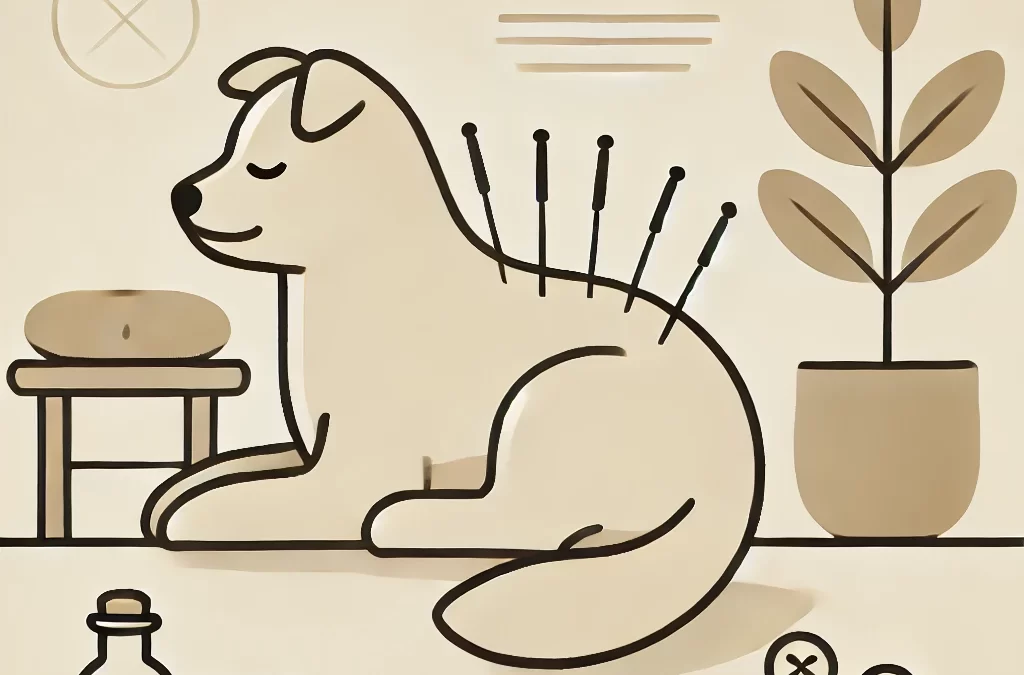
door TCMVET | 22 januari 2025 | Hondenkanker en tumoren
Omdat huisdiereigenaren op zoek zijn naar alternatieven voor conventionele kankerbehandelingen zoals chirurgie, chemotherapie en bestraling, Traditionele Chinese Geneeskunde (TCM) is naar voren gekomen als een veelbelovende complementaire aanpak voor honden met tumoren. TCM ziet kanker als een onevenwicht in de vitale energie van het lichaam (Qi) en streeft ernaar de harmonie te herstellen door kruidengeneeskunde, acupunctuur en dieettherapie. Maar hoe effectief is het? En hoe kunnen we deze behandelingen integreren in een holistisch kankerzorgplan voor honden?
Dit artikel daagt de conventionele opvattingen over de behandeling van kanker bij honden uit door diep in te gaan op de oude wijsheid van TCM, door het te combineren met moderne veterinaire inzichten om een frisse kijk op natuurlijke genezing.
1. Kanker bij honden begrijpen vanuit een TCM-perspectief
In de westerse geneeskunde wordt kanker gezien als ongecontroleerde celgroei vaak getriggerd door genetische, omgevings- of dieetfactoren. TCM interpreteert tumoren echter anders:
- Stagnatie van Qi en Bloed: Tumoren ontstaan wanneer energie en bloed geblokkeerd raken, waardoor een goede bloedsomloop wordt verhinderd.
- Ophoping van vocht en slijm: Overtollig vocht in het lichaam kan condenseren tot grote hoeveelheden.
- Nier- en miltdeficiëntie: Een zwakke orgaanfunctie kan leiden tot een ophoping van gifstoffen, waardoor het lichaam de abnormale cellen minder goed kan opruimen.
De TCM-behandeling richt zich op blokkades verwijderen, orgaanfunctie versterken en immuniteit verhogen in plaats van alleen kankercellen te vernietigen.
2. Kruidengeneeskunde: een natuurlijke benadering van tumorreductie
Chinese kruidenformules voor kanker hebben als doel tumoren verkleinen, immuunfunctie verbeteren en de gezondheid van organen ondersteunenEnkele veelgebruikte kruiden zijn:
- Baituxiao (白兔肖): Bekend om zijn vermogen om tumorgroei te remmen, hitte te zuiveren en het lichaam te ontgiften.
- Huang Qi (黄芪, Astragalus): Versterkt de immuniteit en verbetert de energiestroom, vaak gebruikt in combinatie met conventionele behandelingen.
- Ban Zhi Lian (半枝莲, Scutellaria Barbata): Heeft antikankereigenschappen en ondersteunt de gezondheid van de lever.
- Ling Zhi (灵芝, Reishi-paddenstoel): Een krachtig adaptogeen dat de immuunreactie versterkt en ontstekingen vermindert.
- Dang Gui (当归, Angelica Sinensis): Bevordert de bloedsomloop en voorkomt Qi-stagnatie. Wordt vaak gebruikt bij tumoren die de huid of spieren aantasten.
Deze kruiden worden vaak voorgeschreven in formules die zijn afgestemd op de behoeften van een hond. specifieke constitutie en tumortypewaardoor een gepersonaliseerde behandeling essentieel is.
3. Acupunctuur: pijnbestrijding en genezingsactivering
Acupunctuur wordt veel gebruikt in menselijke kankerpatiënten om pijn te verlichten en het welzijn te verbeteren, en dezelfde principes gelden voor honden. Deze praktijk werkt door het stimuleren specifieke meridiaanpunten, welke:
- Verminder ontstekingen en pijn
- Verbeter de bloedsomloop om tumoren te helpen krimpen
- Ondersteun het immuunsysteem om de voortgang van kanker te vertragen
- Verbeter de spijsvertering en het energieniveau bij verzwakte honden
Acupunctuursessies zijn niet-invasief en goed verdragen door de meeste honden. Veel huisdiereigenaren merken verbeteringen in de mobiliteit, comfort en eetlust na de behandeling.
4. Dieettherapie: genezing door voeding
Voedsel is medicijn in de TCM, en dieetaanpassingen spelen een cruciale rol in ondersteuning van honden met kankerHet doel is om ontstekingen verminderen, Qi voeden en tumorgroei voorkomen door evenwichtige voeding.
Aanbevolen voedingsmiddelen:
- Magere eiwitten: Eend, konijn en vis hebben de voorkeur boven rood vlees, omdat dit ontstekingsbevorderend kan zijn.
- Ontstekingsremmende groenten: Wortelen, broccoli en paddenstoelen zoals shiitake en maitake.
- Gezonde granen: Gierst, quinoa en gerst, die het spijsverteringsstelsel versterken.
- Bouillon van botten: Ondersteunt de spijsvertering en levert essentiële mineralen.
Te vermijden voedingsmiddelen:
- Bewerkte voedingsmiddelen met kunstmatige toevoegingen
- Overmatig vet of olieachtig voedsel, wat bijdraagt aan vocht
- Zoete lekkernijen, omdat men denkt dat suiker voer tumorgroei
Een zorgvuldig afgestemd dieet, gecombineerd met kruiden en acupunctuur, kan helpen het energieniveau te behouden en de algehele veerkracht van een hond te verbeteren tegen kanker.
5. Integratie van TCM met conventionele behandelingen
Hoewel TCM krachtige hulpmiddelen biedt voor het behandelen van tumoren bij honden, werkt het het beste wanneer gecombineerd met westerse veterinaire zorgVeel dierenartsen hanteren nu een integratieve aanpak, waarbij TCM wordt gebruikt in combinatie met chirurgie, bestraling of chemotherapie om:
- Verminder de bijwerkingen van conventionele behandelingen
- Versterk het lichaam van de hond tegen terugkeer van kanker
- Verbeter het algehele comfort en de levensduur
6. Wanneer u TCM moet overwegen voor een hond met kanker
TCM is vooral nuttig wanneer:
- Een operatie is geen optie vanwege de locatie van de tumor of de leeftijd van de hond.
- De hond ondervindt ernstige bijwerkingen van de chemotherapie of bestraling.
- Het doel is palliatieve zorg om de kwaliteit van leven te verlengen in plaats van de kanker te genezen.
Omdat elke hond anders reageert, is het belangrijk om met een TCM-getrainde dierenarts zorgt voor een veilig en effectief behandelplan.
Een holistische toekomst voor de zorg voor hondenkanker
Traditionele Chinese Geneeskunde biedt een zacht maar krachtig benadering van de behandeling van hondentumoren door het aanpakken van de grondoorzaak in plaats van alleen de symptomen. Door het opnemen van kruidengeneeskunde, acupunctuur en dieettherapie, huisdiereigenaren kunnen het welzijn van hun hond verbeteren en bieden een meelevende, natuurlijke weg naar genezing.
De behandeling van kanker zou zich niet alleen moeten richten op het verlengen van het leven, maar ook op de kwaliteit van elke dag verbeteren. Met de juiste balans van TCM en westerse geneeskunde, honden kunnen genieten een comfortabelere, bevredigendere reis, zelfs als u de diagnose kanker krijgt.





